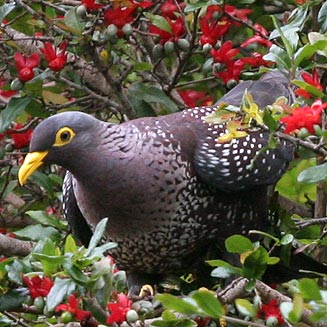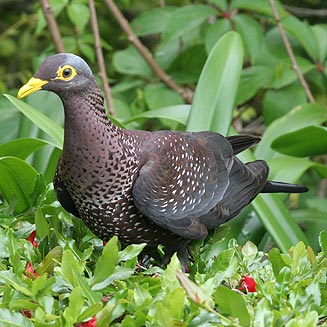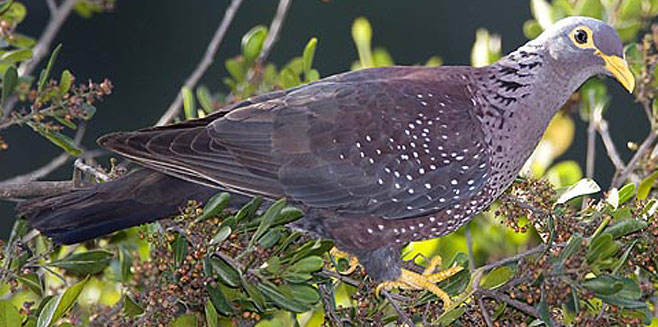|
Columba arquatrix (African
olive-pigeon, Rameron pigeon)
Geelbekbosduif [Afrikaans]; Izuba, Izubantonga
[Xhosa]; iVukuthu-lehlathi [Zulu]; Ngalakana [Tsonga]; Leeba (generic term for
pigeon or dove), Leebaphępane [Tswana]; Olijfduif [Dutch]; Pigeon rameron
[French]; Oliventaube [German]; Pombo-d'olho-amarelo [Portuguese]
Life
> Eukaryotes >
Opisthokonta
> Metazoa (animals) >
Bilateria >
Deuterostomia > Chordata >
Craniata > Vertebrata (vertebrates) > Gnathostomata (jawed
vertebrates) > Teleostomi (teleost fish) > Osteichthyes (bony fish) > Class:
Sarcopterygii (lobe-finned
fish) > Stegocephalia (terrestrial
vertebrates) > Tetrapoda
(four-legged vertebrates) > Reptiliomorpha > Amniota >
Reptilia (reptiles) >
Romeriida > Diapsida > Archosauromorpha > Archosauria >
Dinosauria
(dinosaurs) > Saurischia > Theropoda (bipedal predatory dinosaurs) >
Coelurosauria > Maniraptora > Aves
(birds) > Order: Columbiformes > Family:
Columbidae > Genus: Columba
 |
 |
|
Rameron pigeons in Kirstenbosch Botanical Gardens
feeding on Ochna serrulata fruit. [photos H. Robertson, Iziko
©] |
 |
|
Rameron pigeon. [photo
Johann Grobbelaar ©] |
The African olive pigeon is found mainly in South Africa,
with a small population on the border between Mozambique and Zimbabwe. It lives
mainly in indigenous forests, as well as suburban gardens and parks, where it
can be found in fruit trees or bushes, its main source of food. The female
builds the nest, with the male collecting the material, and putting it on the
female's back, who then puts it underneath her body. It lays 1-2 eggs, which are
incubated by both sexes, changing shifts in the early morning and late
afternoon. The chicks are fed by both parents, and leave the nest after 19-20
days.
Distribution and habitat
Occurs from Ethiopia through Uganda, Kenya, Tanzania and
Angola to southern Africa. Within southern Africa it is common in eastern and
southern South Africa, Swaziland and Zimbabwe's eastern highlands and adjacent
Mozambique. It generally prefers
evergreen forests, riverine forests and thickets, alien tree plantations,
urban gardens and parks, provided there are plentiful fruit trees and bushes.
|
 |
|
Distribution of African olive-pigeon in southern Africa,
based on statistical smoothing of the records from first SA Bird Atlas
Project (©
Animal Demography unit, University of
Cape Town; smoothing by Birgit Erni and Francesca Little). Colours range
from dark blue (most common) through to yellow (least common).
See here for the latest distribution
from the SABAP2. |
Predators and parasites
Food
Feeds almost exclusively on fruit,
rarely feeding on fallen seeds on the ground. It usually forages in the canopy
of fruiting trees, rarely going to the ground to feed on fallen seeds. The
following food items have been recorded in its diet:
- Fruits
- Apodytes dimidiata (White-pear)
- Celtis africana (White stinkwood)
- Calodendron capense (Cape chestnut)
- Cassine crocea (Spoonwood)
- Cassine capensis (Spoonwood)
- Chrysanthemoides monilifera (Bushtick-berry)
- Dovyalis rhamnoides (Sourberry)
- Ekebergia capensis (Cape-ash)
- Euclea crispa (Guarris)
- Euclea natalensis (Guarris)
- Ficus craterostoma (Forest fig)
- Other Ficus species
- Halleria lucida (Tree-fuchsia)
- Ilex mitis (African holly)
- Kiggelaria africana (Wild-peach)
- Morella cordifolia (Dune waxberry)
- Ocotea bullata (Stinkwood)
- wild olive
- Olea capensis
- Olea faveolata
- Olea verrucosa
- Olea woodiana
- Olinia cymosa (Hard-pear)
- Olinia emerginata (Hard-pear)
- Afrocarpus falcatus (Yellowwood)
- Podocarpus latifolius (Yellowwood)
- Podocarpus elongatus (Yellowwood)
- Prunus africana (African almond)
- Rapanea melanophoeos (Cape-beech)
- Rhoicissus tomentosa (Common forest grape)
- Scolopia mundii (Red-pear)
- Sederoxylon inerme (White milkwood)
- alien species
- Ligustrum (pivets)
- Prunus capuli (Mexican cherry)
- Phytolacca dodecandra (Inkberry)
- Phytolacca octandra (Inkberry)
- Solanum mauritanum (Bugweed)
- Duranta repens (Forget-me-not bush)
- Seeds
- Acacia cyclops (Rooikrans)
- Acacia mearnsii (Black wattle)
- Pinus pinea (Umbrella pine)
- Carya pecan (Pecan nuts, eaten whole)
- Recorded to eat mud at salt spring, reason unknown.
Breeding
- It builds its own nest, the male collecting material then giving it to the
female, who then adds it to the structure. The
nest is a circular collection of twigs, with a depression in the middle,
sometimes lined with leaves. Nests can be found in forks in trees such as African olive
(Olea africana), White milkwood (Sideroxylon inerme)
and sometimes pines (Pinus).
- Egg-laying season is year-round.
- It lays 1-2, usually one egg, which are incubated by both sexes for
about 20 days, changing
shifts in the early morning and late afternoon.
- The chicks are fed by both parents, leaving the nest after 19-20 days.
Threats
Not threatened, but might be at risk due to destruction and
fragmentation of forests.
References
-
Hockey PAR, Dean WRJ and Ryan PG 2005. Roberts
- Birds of southern Africa, VIIth ed. The Trustees of the John Voelcker
Bird Book Fund, Cape Town.
|
